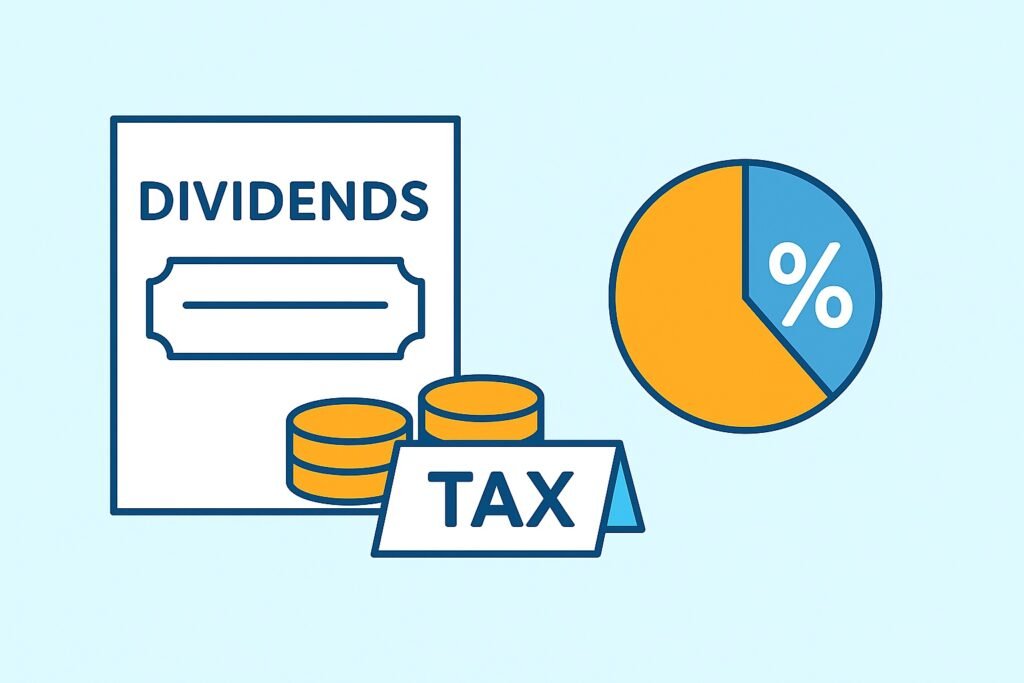
If you are a shareholder in a limited company, you pay tax on any dividends you receive. This guide explains how dividends are taxed and how to calculate your tax liability.
All company dividends – whether they are from stock market listed firms or your own limited company – are taxed in the same way.
Any income you receive as company dividends is taxed separately from your salary or pension income.
One important point to note is that no tax is due on dividends received from shares held in an ISA.
If you run your own company, the most tax-efficient way to draw down funds from the business is via dividends, as no employers’ NICs are payable, whereas they are on salaries.
This guide has been updated for the 2025/26 tax year.
Table of Contents
- How to distribute company dividends
- When to pay dividends
- Beware illegal (ultra vires) dividends
- 2025/26 dividend tax rates
- Dividend allowance
- How to calculate dividend tax
- Notifying HMRC and paying tax
- Dividend paperwork required
How to distribute company dividends
To work out the total amount of dividends that can be distributed to company shareholders, you need to subtract the value of all company expenses from your turnover.
Expenses include all amounts the business owes, including taxes, at any given point in time.
These retained earnings can be distributed as dividends to shareholders, and the funds must be distributed in proportion to the percentage shareholding each shareholder owns.
If you have retained profits brought forward from previous accounting periods, these can also be distributed as dividends.
Chances are, you already use some online accounting software, such as FreeAgent.
Assuming you keep your accounts up to date, you should be able to tell exactly what dividend distribution you can legally make from the company. If you are unsure, please get in touch with your accountant.
When to pay dividends
No rules govern how frequently you can distribute dividends, although many larger companies do so every quarter.
It may suit you to distribute dividends to coincide with your VAT quarter (if you are registered).
You may prefer monthly dividends for cashflow reasons, although some accountants we work with advise against this.
Regular dividend payments might appear more like a ‘salary’ in all but name. HMRC could challenge regular payments and reassign them as employment income, subject to Employers’ NICs.
Only distribute retained profits, or risk paying it back
The key thing is that you must only distribute your company’s retained earnings.
If you ignore this and pay yourself a dividend when there aren’t enough retained earnings to cover it, you’re making what’s known as an illegal dividend – or an ultra vires payment.
These are technically repayable. HMRC may treat the money as a loan or salary instead, which could result in additional tax charges.
Worse still, if your company runs into financial trouble, you could be asked to repay the ‘dividend’ personally.
Accountants tend to take this seriously, and so should you. Stick to distributing profits that have been properly earned and recorded.
2025/26 dividend tax rates
Your Income Tax bands determine the tax you pay on dividends over your £500 dividend allowance (see below).
- Personal Allowance (up to £12,570) – no tax to pay – most people’s tax code is 1257L
- Basic Rate (£12,571 to £50,270) – 8.75%
- Higher Rate (£50,271 – £124,100) – 33.75%
- Additional Rate (over £125,140) – 39.35%
Dividend allowance
Every individual receives a dividend allowance each year. This allows you to receive a certain amount of dividend income without paying any tax. However – interestingly – the allowance still takes up £500 of your tax band.
The dividend allowance for the 2025/26 tax year is £500. This means you don’t need to pay tax on the first £500 of dividend payments you receive. You can find out more here.
How to calculate dividend tax
Use this dividend tax calculator to work out how much you’ll owe.
Also, read our guide to working out the best salary/dividend split for directors.
Example 1 – Basic Rate taxpayer
Jack receives £8,000 in dividend payments and earns £30,000 in salary, totalling £38,000 in income.
Only £7,500 of dividends are taxable, as the £500 dividend allowance has been deducted.
- The first £12,570 of salary is tax-free (within the personal allowance).
- The next £17,430 of salary is taxed at the income tax basic rate (deducted via payroll).
- The first £500 of dividends is tax-free (the dividend allowance).
- The remaining £7,500 of dividends are taxed at the dividend tax basic rate (8.75%) = £656.25
- Jack’s total dividend tax bill is £656.25
Example 2 – Higher Rate taxpayer
Emma earns £15,000 in salary and draws down £40,000 in dividends.
Only £39,500 of dividends are taxable, as the £500 dividend allowance has been deducted.
- The first £12,570 of salary is tax-free (within the personal allowance).
- The next £2,430 of salary is taxed at the income tax basic rate (deducted via payroll).
- The first £500 of dividends is tax-free (the dividend allowance).
- The next £34,770 of dividends are taxed at the dividend tax basic rate (8.75%) = £3,042.375
- The remaining £4,730 of dividends are taxed at the dividend tax higher rate (33.75%) = £1,596.375
- Emma’s total dividend tax bill is £4,638.75
Notifying HMRC and paying tax
If you receive over £10,000 in dividends in the tax year, you must complete a Self Assessment tax return.
If your dividend income is more than £500 but under £10,000 and you don’t usually file a return, contact HMRC – they may adjust your tax code to collect the tax automatically.
You don’t need to notify HMRC if your dividend income is below the £500 allowance.
See the official guidance at GOV.UK.
Dividend paperwork required
You must include the following details on dividend vouchers for each shareholder.
- The date.
- The company name and registered number.
- The type of security is usually ‘Ordinary Shares’.
- The shareholder’s name and address.
- The number of shares held by the recipient.
- The amount of the dividend payment.
- Signature (real or electronic) of a Company official.
Additionally, it is advisable to include a unique reference number for internal tracking purposes, and optionally, the method of payment (e.g., bank transfer). This helps maintain clarity, especially if there are multiple dividend distributions in a financial year.
We have also provided an example dividend voucher below. We recommend you check with your accountant if you have any questions about declaring dividends.
Dividend Voucher
Ltd Company Name & Registered Address
The board of directors of YOUR COMPANY LIMITED met at [ADDRESS] on [DATE] and declared an interim dividend of £X per Ordinary Share in respect to the financial year ended [YEAR END DATE] payable to shareholders registered at the close of business on [DATE].
Shareholder Name & Address
—–
No. of Shares (and type of Share – usually “ORDINARY SHARES”)
Dividend Payment:
—-
Signed By:
Company Official (e.g. Director / Company Secretary).
Optional: Payment Method – e.g. “Bank Transfer to [Account Ending XXXX]”
Board Meeting Minutes
Limited companies are legally obliged to keep records of all dividends made, via board meeting minutes.
An example statement from board meeting minutes would be:
It was resolved that an interim dividend of £X per Ordinary Share in respect of the year ended [YEAR END DATE] be declared on the Ordinary shares and payable on [DATE] to Ordinary shareholders registered at the close of business on [DATE].
The minutes should be signed and dated by at least one director and stored securely as part of the company’s statutory records.
Some companies also choose to include a reference to the dividend payment in their management accounts for full traceability.
Final thoughts
Most small businesses use online accounting software like FreeAgent, which auto-generates dividend vouchers and minutes.
Even when using software, directors must ensure that dividends are only issued when sufficient distributable profits exist. Otherwise, they may be classed as illegal (‘ultra vires’) dividends.
As always, speak to your accountant if you’re unsure about any part of the process.
You can read the official guide to tax on dividends at GOV.UK.
Finally, tax is a complex subject, so it is essential to always consult with your accountant before relying on any information in this article.

